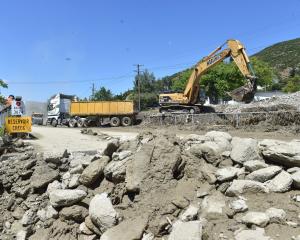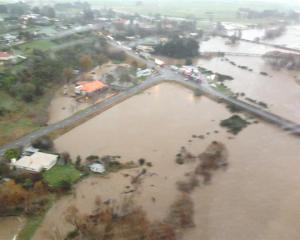• See pictures of flooding in Southland
Southlanders started a large mop-up operation yesterday as floodwaters started to recede, although the general opinion was that the local flood protection scheme saved the province from the worst.
More than 700mm of rain has fallen in the region over the past three days, forcing major rivers in the area to rise to their highest levels in more than 10 years.
The effects of the downpour were felt widely across the province, first in Te Anau on Monday, where it knocked out phone lines, prompted the evacuation of trampers and caused the closure of roads and schools.
Both the Milford and Routeburn tracks are closed because of slips, washouts and several bridges having been washed away.
The Kepler Track has been slightly damaged but is open.
The Department of Conservation is advising people to stay out of the area until the weather has improved and it has had an opportunity to further assess damage in the park.
The Central Southland town of Winton was spared early yesterday as water surging down the nearby Oreti River at the same levels as were experienced in Southland's 1999 floods, was contained within the floodbanks.
About six hours later, the peak of the flood reached Wallacetown and threatened to breach the floodbanks.
It was mostly contained and pooled with water from the swollen Makarewa River in the Taramoa ponding area, north of the Invercargill Airport.
Overflow from the Aparima River spilled on to roads near Riverton and Thornbury.
The Mataura River peaked at Gore at 1.30pm, without incident.
Some Te Anau residents were still experiencing landline telephone issues last night, and the number of roads that remained closed by surface flooding last night prompted warnings from police for motorists to exercise caution in the area.
It would be several days before the Whitestone Bridge would be fixed, NZTA Otago-Southland regional director Bruce Richards said.
It "wasn't a biggie", had happened before, in the 1980s, and could easily happen again, he said.
Large tracts of land along the lengths of the affected rivers and their tributaries were still under water last night, but farmers told media yesterday the overriding opinion was that it was "wonderful" the flood protection system had held back such a large event.
Federated Farmers' national spokesman on adverse events David Rose, a Waianiwa farmer, said it was lucky it was the time of year when the least stock were on farms.
He had not heard of any stock casualties so far.
He praised the flood protection system and said Environment Southland had done a great job of giving people notice.
The main issues so far appeared to be damage to fences and winter feed, including balage and paddocks of swedes, he said.
In the worst incidents involving people, a man and a woman, driving separate vehicles both had to be rescued when they tried, and failed, to drive through surface flooding at Thornbury.
A Fire Service spokesman said the man's car was swept off the road first, about 1am.
When he got out, he was pinned to a fence by the water and required rescuing by the local fire brigade.
The woman's car was swept off the same stretch about 7.15am.
She climbed on to her car's roof, which was nearly submerged, and was rescued by locals, using a tractor.
Neither person was injured.
With the rain easing, Environment Southland's focus was turning to erosion along the riverbanks and what repair work was required, a spokeswoman said.
Civil Defence emergency management group controller Neil Cruickshank said it would take several days, if not weeks, to gather a full picture of the losses, including damage to public assets such as stopbanks, roads and bridges, and private property.




